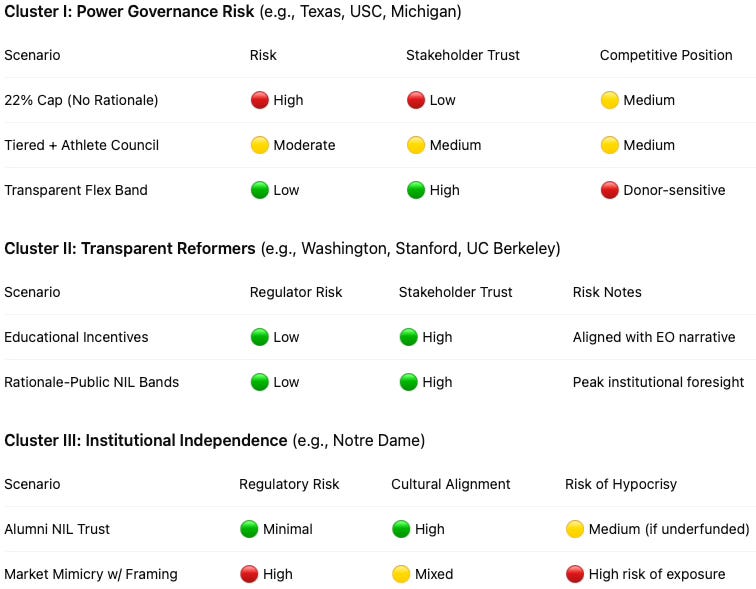MCAI Lex Vision: Executive Foresight and the New Era of NCAA Institutional NIL Legitimacy
Strategic Simulation of Post Trump Executive Order NCAA Governance: From Compliance Illusions to Structural Coherence
I. Introduction: The Federalization of Foresight
The July 24, 2025 Executive Order issued by President Donald J. Trump has transformed NIL policy from a decentralized, litigation-prone arena into a federally surveilled battleground of narrative control and institutional legitimacy. While framed as a preservationist measure to protect amateurism, women’s sports, and Olympic pathways, the order effectively demands that colleges demonstrate foresight, transparency, and mission alignment or risk reputational degradation and regulatory targeting.
This MindCast AI (MCAI) Lex Vision statement introduces a new simulation framework for institutional survival in a post-EO NIL era. We move beyond static legal compliance to dynamic coherence modeling: schools must now anticipate how federal enforcement, narrative weaponization, and internal policy contradictions will affect their public trust, legal exposure, and cultural identity. The institutions that endure will not be the most compliant, but the most narratively resilient. The sections that follow explain how MCAI's predictive architecture supports this shift.
Contact mcai@mindcast-ai.com to partner with MindCast AI LLC.
II. From Policy to Posture: How the EO Rewrites the NIL Equation
The Trump Executive Order does not directly legislate NIL terms, but it redefines the posture institutions must adopt. The federal government has reframed NIL not simply as a regulatory matter but as a test of institutional purpose and public coherence. In doing so, it elevates governance narratives and value alignment to strategic assets—and exposes those without them to structural risk.
The EO activates four irreversible pressures: narrative enforcement, regulatory alignment, structural differentiation, and federal preference signaling. Together, they render shallow compliance obsolete. MCAI anticipated this shift and modeled it across dozens of scenarios. Now, schools must re-interpret NIL policy as a visible expression of identity and foresight.
Conclusion: This is not just a policy change—it is a new national alignment of story, structure, and scrutiny. The cost of narrative incoherence has risen. Institutions that fail to lead with clarity will be governed by those that do.
III. MCAI Simulation Framework: Coherence Over Compliance
In response to the EO, MCAI has updated its NIL foresight simulations to reflect a post-compliance landscape. Rather than test institutional legality alone, we now simulate narrative durability, stakeholder trust elasticity, and mission coherence across multi-regulatory scenarios. This infrastructure models not only outcomes, but also the behaviors and responses that produce them.
A. Cognitive Digital Twins (CDTs) These digital agents mirror how key institutional actors respond under stress: trustees, athletes, donors, regulators, and journalists. We simulate their behavior under different NIL policies to identify trust thresholds, convergence triggers, and regulatory risk.
B. Institutional Risk Matrix (IRM) MCAI scores institutions across three tiers:
C. Scenario Forecast Grid Schools are modeled across four policy futures:
Conclusion: MCAI doesn’t just help institutions follow policy. It simulates how policies behave under pressure, how stories fracture, and how trust is lost or earned. Foresight is no longer a supplement—it’s structural defense.
IV. Strategic Simulations Post-EO: Three Archetypes
Across simulations, MCAI has identified three dominant institutional archetypes: Power Governance Risk, Transparent Reformers, and Institutional Independents. Each faces different exposures, strategic options, and federal optics. Simulating their choices clarifies which policies will reinforce coherence—and which will invite collapse.
Conclusion: Every institution has structural options, but not every option holds up under scrutiny. MCAI helps simulate not just what works—but what will be seen as honest, fair, and defensible.
V. Recommendations: From Legal Armor to Institutional Evolution
The path forward is no longer about regulatory escape velocity. It’s about coherence under spotlight. MCAI proposes five structural upgrades that increase narrative resilience and reduce regulatory friction:
NIL Rationale Disclosures: Publish the educational justification for compensation tiers.
Athlete Advisory Committees: Formalize co-governance of NIL policy.
Flexible Compensation Bands: Replace ceilings with ranges justified by mission.
Fiduciary NIL Reviews: Make NIL governance part of annual trustee audits.
Simulation Protocols: Run annual foresight loops on trust, legality, and media framing.
Conclusion: These are not compliance tools—they are narrative integrity safeguards. Schools that implement them will not just survive scrutiny. They will lead the NIL era.
VI. Conclusion: The Compliance Era Is Over. Coherence Is the New Currency.
The Executive Order has accelerated the transformation of college sports governance. Legal compliance, while necessary, is now the floor. Above it lies a new architecture of foresight, narrative control, and cultural trust. MCAI foresight simulations reveal that institutions capable of justifying their actions with transparency, mission alignment, and public coherence will not only pass regulatory tests—they will set the standard.
The question for schools is no longer "Are we compliant?" but rather, "Are we coherent under fire?" MCAI exists to answer that question—and prepare institutions to thrive when the answer matters most.






